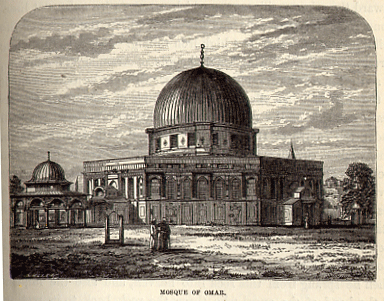
Illustration of Cairo from Seward’s Travels (1873)
William H. Seward, the American Secretary of State who is forever linked with the “folly†of acquiring Alaska from the Russians, spent a year traveling around the world near the end of his life. In three previous posts I posted the comments he and his daughter made about India and Aden, and Egypt. The journey continued to Palestine and the city of Jerusalem:
Yussef Effendi, with the brother and secretary of the pacha, attended us to the Mosque of Omar. It is only within the last five years that this mosque, scarcely less sacred in the eyes of Mussulmans than the Church of the Holy Sepulchre is in ours, has been opened to Christian travelers. Even now a careful, though somewhat disguised surveillance, is practiced over them. The mosque stands in an area enclosed with a high, parapeted wall, overlooking the vally of Jehoshaphat, and confronting the Mount of Olives. This occupies one-sixth of the land of the entire city. On the eastern side of this wall is a gate-way, built of marble, called by the Mussulmans the “Golden Gate,†which they are fond of representing as the “gate of the temple called Beautiful,†but its modern architecture does not support that claim. It is only interesting from the tradition that it was closed with the Roman conquest, and has never been reopened. The so-called Mosque of Omar is not single. It consists of two distinct mosques, placed at some distance from each other – the one here named Kubbet-es-Sukhrah, or “the Dome of the Rock,†commonly called the Mosque of Omar, and the Mosque-el-Aqsa. Though differing entirely from the Church of the Holy Sepulchre, the Mosque of Omar is not less unique and peculiar in its sacred antiquities. Twelve hundred years ago, on the surrender of the Greek Patriach, the Caliph Omar demanded to be shownt he site of the Jewish temple. He was taken to the sacred rock, he knelt and prayed over it, and he built over it a mosque, which, with subsequent repairs, is the present “Dome of the Rock,†or Mosque of Omar. In architectural design and execution it rivals the finest in Cairo and Constantinople. Antedating the conquest of the Mussulmans in India, it has an elaborateness of embellishment, perhaps resulting from the influence of Greek and Roman art, which distinguishes this and the other religious structures of modern Asia from the more severe, simple, and effective style of the mosques of Agra and Delhi. One would say, in comparing the two styles, that the Mosque of Omar has borrowed from the superstitions of the West, while those of India indicate a puritanical reformation. It is now sadly out of repair. Its magnificent gilded dome is blackened, and its stained glass windows are broken; the exquisite Arabic tracery marred, and the elaborately-inscribed texts from the Koran faded. Like the Holy Sepulchre, it is replete in all parts with relics and memorials sacred by the Mussulman faith. The sheikh of the mosque reverently removed for Mr. Seward the crimson-silk canopy which covers an irregular, flat limestone rock, sixty feet wide and five feet high, in the centre of the building, and encircled by a high iron railing…
We passed over the neglected court to the Mosque-el-Aqsa. It is said to occupy the place and to retain the form of a Christian church or basilica which the Emperor Justinian built in the sixth century, in honor of the Virgin, and which was temporarily restored by the Crusaders. A part of it was assigned as an encampment for the military order then recently created by Saint-Louis, which from that circumstance took the name of Knights Templars, and which was so active and powerful throughout the centuries.
El-Aksa is indeed a structure built in the customary design of the basilica. Its dimensions are two hundred and seventy-two feet long, by one hundred and eighty-four feet wide. It has seven aisles, supported by forty-five columns, of which thirty-three are marble, and are chiefly of the Corinthian order. But, what interests us more is, a recent excavation under the pavement of this mosque, which proves to be an ancient gate. It has been closed and walled up, while the city had been built around it on the outside. The massive though broken floor, the solid columns, and the heavy transverse stones which rest upon them, are wrought in a style neither Saracenic nor Greek, but shaped and ornamented in a manner which we remarked in the Egyptian temples. This newly-discovered gate-way is believed, by the distinguished explorer Captain Wilson, to have been one of the original entrances to the Temple of Solomon. Not only El-Aqsa, but the whole area enclosed within the outer walls, now wears the appearance of neglect, dilapidation, and decay. Is this an evidence of the decline of the Mohammedan religion, or only of the increasing isolation of Jerusalem? We must go father into the Turkish Empire to decide. Meantime, it is suggestive of much thought that not only the Mayor of Jerusalem, but the obliging sheik of the mosque, plaintively and earnestly invoked Mr. Seward to use what they thought would be an influence of some weight with the Sultan of Constantinople, for the repair of the Mosque of Omar.
Excerpts from Olive Risley Seward, editor, William H. Seward’s Travels around the World (New York: Appleton and Company, 1873), pp. 590-593)